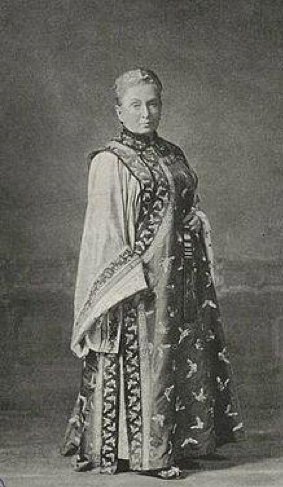The second half of the 19th century was characterised by the rise of the tourism industry. The number of people travelling around the world increased and the elite sought to differentiate themselves from tourists who had fewer resources and less time to travel. The opening of the Suez Canal (1869) was one of the elements that made travelling to Asia easier. However, Ida Pfeiffer (1797-1858) completed her first trip around the world between 1846 and 1848. Emilia Serrano (1834-1923) and María de Maeztu (1881-1948) were two other prestigious women who had their lives marked by constant travelling. Mary Kingsley, from England, stands out as an anthropologist and explorer. Amelia Earhart defended de role of women in the aviation world. She lost her life in the Pacific Ocean, while trying to go around the world by plane in 1937.

Isabella Lucy Bird
Boroughbridge Hall (Yorkshire), England, 15-10-1831 — Edinburgh (Scotland), 08-10-1904
Period of activity: 1856 — 1901
Geographical classification: Europe > United Kingdom
Socio-cultural movements
Late modern period / Contemporary period > Socio-political movements > Imperialism
Late modern period / Contemporary period > Socio-political movements > Colonialism
Groups by dedication
Travellers / Expeditionaries > Travellers
Travellers / Expeditionaries > Expeditionaries
Scientists > Natural philosophers / Naturalists
Humanistics > Geographers
Writers
Plastic, visual and performing artists > Photographers
Context of feminine creation
Review
Middle-class traveller who wrote several travel books. Her numerous trips, publications and observations made her the first woman to be allowed to join the Royal Geographical Society. During her last years, she decided to study medicine and give a bigger meaning to her trips by becoming a missionary.
Justifications
Biography
Isabella Lucy Bird was a British traveller, writer, photographer, and naturalist in the 19th century. She was the first woman to be elected member of the Royal Geographical Society. In her last years, she founded two hospitals in India and became a missionary.
When she was little, she had a frail health. She underwent surgery for a tumour in the spine. Doctors recommended fresh air and physical exercise, and so she learned rowing and horse riding. Her first trips were to Scotland, with her family. In 1854 she was advised to take a trip to the sea, so she travelled to the United States with some relatives. Her first book, An Englishwoman in America, was the result of the letters that she sent her sister during this trip.
Her second trip started in 1872, and she visited Australia, Hawaii, and Colorado. She climbed the Manua Kea and the Manua Loa, and she rode a horse for 1300 km in the Rocky Mountains. She had a close relationship with Rocky Mountain Jim, the outlaw. Her third trip, between 1878 and 1880, brought her to Japan, China, Korea, Vietnam, Singapore and Malaysia.
After the death of her sister, she married doctor John Bishop. He passed away in 1886. At that point, she decided to study medicine and travel as a missionary.
In 1889, she settled in India, where she founded two hospitals. Shortly after, she travelled through Iraq, Iran, Persia, Kurdistan and Turkey. Her last trip was to Morocco in 1901.
Works
The Englishwoman in America (1856)
A Lady's Life in the Rocky Mountains (1879)
Unbeaten Tracks in Japan (1880)
The Golden Chersonese and the Way Thither (1883)
A Pilgrimage To Sinai (1886)
Journeys in Persia and Kurdistan (1891)
Among the Tibetans (1894)
Korea and her Neighbours (1898)
The Yangtze Valley and Beyond (1899)
Chinese Pictures: notes on photographs made un China (1900)
Notes on Morocco(1901)
Bibliography
Álvarez Faedo, María José (2020). “El viaje como terapia: Isabella Bird en las Montañas Rocosas”, Candau Chacón, Mª Luisa (ed.), Viajeras de Élite. Experiencias, recorridos, textos. Siglos XIX-XX, Bern, Peter Lang, pp. 137-190.
Barr, Pat (1985). A curious life for a lady: the story of Isabella Bird, a remarkable Victorian traveller. Leicester: Charnwood.
Colorado Women´s Hall of Fame, retrieved on 22/03/2022, <https://www.cogreatwomen.org/project/isabella-bird/>
Glauber, Carole (2002). Isabella Bird Bishop: Korea, the Yangtze Valley, and Beyond. Photo Review.
Isabella Bird's Map in America, retrieved on 22/03/2022, <Isabella Bird's American Adventure- A Lady's Life in the Rocky Mountains>
Nipon.com. Una ventana a Japón, retrieved on 22/03/2022, <ht0tps://www.nippon.com/es/japan-topics/g00829/>
Stoddart, Anna M (1906). The Life of Isabella Bird, Mrs Bishop, Londres, J. Murray.
Woman Essentia, retrieved on 22/03/2022, <https://www.womanessentia.com/personas/hicieron-historia/isabella-bird-la-viajera-victoriana-que-se-aventuro-en-china/#:~:text=Fue%20una%20pionera%20en%20esto,las%20regiones%20que%20estos%20ba%C3%B1an>
Didactic approach
She can be included in several subjects. In History of the Contemporary World in 1st of Bachillerato, when explaining the Industrial Revolution and European Imperialism. And in Foundations of art in 2nd of Bachillerato, in connection to Romanticism.